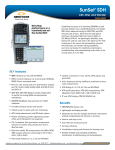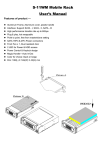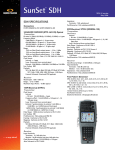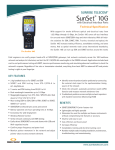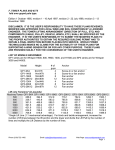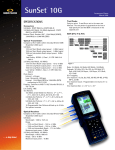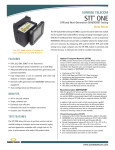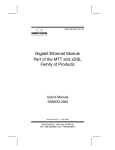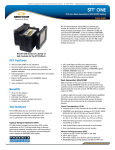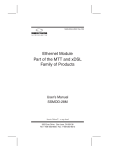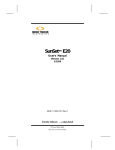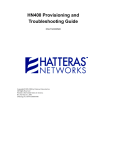Download SunSet® SDH - Velcom-t.ru
Transcript
SUNRISE TELECOM® ® SunSet SDH with Jitter and Wander Benchtop performance in a handheld test set - the SunSet SDH Data Sheet Combining the power of a benchtop SDH/PDH set and protocol analyzer into a handheld platform, the SunSet SDH offers advanced testing for SDH, PDH, and ATM networks and services. With electrical and optical interfaces, the SunSet SDH tests from 64 kbit/s to 2.5 Gbit/s (STM-16). Its lightweight, durability, long battery life, and low cost make it the ideal tool for field technicians in the access and metropolitan networks. And with jitter and wander testing capabilities, save time and money for installation, maintenance, troubleshooting, and commissioning tasks, either at the central office or in the field. KEY features • SDH testing at 52, 155, 622 Mbit/s and 2.5 Gbit/s • PDH & T-Carrier testing at 1.5, 2, 34, 45, and 139 Mbit/s; PDH/T-Carrier structured mode • Bit error rate testing and error performance analysis per ITU-T G.821, G.826, G.828, G.829, M.2100, M.2101, and M.2110 • SDH-SDH, SDH-PDH MuxTest modes; Independent Tx and Rx for testing ADMs and synchronous multiplexers • Tandem connections: errors, alarms, APId capture and generation • Voice frequency testing: talk/listen, send/receive tones, noise measurements • ATM testing at 1.5, 2, 34, 45, 155, 622 Mbit/s and 2.5 Gbit/s • ATM traffic generation, ATM QoS measurements, ATM Adaptation Layer (AAL0, AAL1, AAL2, AAL5) tests • IP over ATM testing, ATM DSL DSLAM test • SDH/PDH MuxMode: drop and insert of 1.5/2M tributaries • Full SDH overhead control and decode • Tributary scan for alarm and error monitoring • APS timing measurement and APS bytes capture • Pointer monitoring, pointer adjustment, pointer offset and G.783 pointer test sequences • ITU-T compliant Jitter generation, measurement, tolerance & transfer tests, pointer jitter test in MuxTest mode • Real time wander TIE measurements and offline MTIE/TDEV analysis software conforming to ITU-T G.811, G.812, G.813, G.823 • Pulse mask analysis at 1.5, 2, 34, and 45 Mbit/s benefits • SDH/PDH/ATM feature-rich • Lightweight and highly portable • Eliminates the need for multiple and heavier instruments without compromising test features or accuracy • Intuitive and easy-to-use • Cost-effective and future-proof • Increases efficiency • Consolidates training and shortens the learning curve • Handles multiple tasks including installation, maintenance, troubleshooting, and commissioning www.sunrisetelecom.com Applications Installation, Maintenance, Troubleshooting & Commissioning The SunSet SDH is the ideal product for installation and bringing Out-of-Service testing ADM Tx Tx ADM STM-16 Optical Ring Rx into service tasks in the field and central office. Commission- ADM Rx ADM ing and acceptance tests can be performed with the same test set, as jitter and wander features are part of the conformance procedures. Maintenance and troubleshooting in-service tasks Round trip delay SDH/PDH interface can also be completed with the same handheld test set saving NE Network time and money. Out-of-Service Testing • End-to-end BERT Jitter generation/measurement Jitter Generation • Bringing into Service per ITU-T M.2110 Tx Rx • ATM testing NE Rx • Trace generation Tx Jitter Measurement • Round trip delay • NE verification NE Jitter tolerance/transfer measurements • Pulse mask analysis at 1.5M, 2M, 34M, and 45M Jitter • Voice frequency testing: Talk/listen, send/receive tones NE Error • MuxTest • Jitter tests – Jitter generation and measurement MuxTest, Pointer jitter tests – Jitter tolerance and transfer measurement High rate side Low rate side – Pointer/mapping jitter test • Wander tests Rx Tx Tx Rx In-Service Monitoring • Through protected monitoring points or optical splitters • Line through and payload through mode • Error performance analysis per G.826, G.828, G.829, Wander testing M.2101 Tx Rx L1-Rx Tx NE • SDH overhead bytes decode • Pointer monitoring L2-Rx External Clock • APS timing measurement and APS capture • In-service tributary scan • Voice traffic monitoring • In-service jitter/wander measurements • Troubleshooting synchronization problems Wander Measurement Primary Reference Clock/Signal In-Service monitoring ADM STM-16 Optical Ring ADM Through mode 2 SunSet ® SDH Rx ADM ADM SDH specifications 2.5G/622M/155M/52M Optical (STM-16/4/1/0) Port/Connector: FCUPC or SCUPC Line coding: NRZ Mode: Single and multi-mode compatible Complies to ITU-T G.957 Framing: Conforms to ITU-T G.707 Mapping: Conforms to ITU-T G.707 Transmitter Clock source Internal: ± 4 ppm – Bit rates 2.5 Gbit/s, 622 Mbit/s, 155 Mbit/s, 52 Mbit/s: ± 4 ppm Frequency offset – 2.488 Gbit/s ± 50 ppm in 1, 10 ppm steps – 622.080 Mbit/s ± 50 ppm in 1, 10 ppm steps – 155.520 Mbit/s ± 50 ppm in 1, 10 ppm steps – 51.840 Mbit/s ± 50 ppm in 1, 10 ppm steps Loop: Recovered from received signal External: Synchronization to external 1.544 MHz or 2.048 MHz via 1.5/2M External Clock input 1.5/2M-L2-Rx: Synchronization to external 1.544 Mbit/s or 2.048 Mbit/s via 1.5/2M Line 2 input Output power range 155/622 Mbit/s – 1310 nm Intermediate Reach: -8 to -15 dBm – 1310 nm Long Reach: +2 to -3 dBm – 1550 nm Long Reach: +2 to -3 dBm 2.5 Gbit/s – 1310 nm Short Reach: -3 to -10 dBm – 1310 nm Intermediate Reach: 0 to -5 dBm – 1310 nm Long Reach: +3 to -2 dBm – 1550 nm Intermediate Reach: 0 to -5 dBm – 1550 nm Long Reach: +3 to -2 dBm Laser Safety: IEC825-1, Class 1, 21 CFR 1040.10 & 1040.11 Receiver Frequency recovery range 2.48832 Gbps ± 50 ppm 622.080 Mbps ± 50 ppm 155.520 Mbps ± 50 ppm 51.840 Mbps ± 50 ppm Wavelength: 1280 -1580 nm Input power range 155/622 Mbit/s – 1310 nm Intermediate Reach: -30 dBm – 1310 nm Long Reach: -30 dBm – 1550 nm Long Reach: -30 dBm 2.5 Gbit/s – 1310 nm Short Reach: -18 dBm – 1310 nm Intermediate Reach: -18 dBm – 1310 nm Long Reach: -28 dBm – 1550 nm Intermediate Reach: -18 dBm – 1550 nm Long Reach: -28 dBm Maximum input power – 1310/1550 nm Short or Intermediate Reach: +3 dBm – 1310/1550 nm Long Reach: -5 dBm 155M Electrical (STM-1) Port/Connector: 75Ω unbalanced BNC (f) Line coding: CMI Framing: Conforms to ITU-T G.707 Mapping: Conforms to ITU-T G.707 Transmitter Clock source Internal − Bit rate: 155.520 Mbit/s ± 4 ppm Frequency offset: 155.520 Mbit/s ± 50 ppm in 1, 10, 100 ppm steps Loop: Recovered from received signal External: Synchronization to external 1.544 MHz or 2.048 MHz via 1.5/2M External Clock input 1.5/2M-L2-Rx: Synchronization to external 1.544 Mbit/s or 2.048 Mbit/s via 1.5/2M Line 2 input Pulse shape: 155M electrical conforms to ITU-T G.703 Receiver Frequency recovery range: 155.520 Mbit/s ± 150 ppm Input sensitivity Terminate: 12.7 dB cable loss Monitor: 20 dB resistive loss plus 12 dB cable loss Jitter tolerance: Conforms to ITU-T G.825 Impedance: 75Ω unbalanced 52M Electrical (STM-0) Port/Connector: 75Ω unbalanced BNC (f) Line coding: B3ZS Framing: Conforms to ITU-T G.707 Annex A Mapping: Conforms to ITU-T G.707 Transmitter Clock Source Internal − Bit rate: 51.840 Mbit/s ± 5 ppm Frequency offset: 51.840 Mbit/s ± 500 ppm in 1, 10, 100 ppm steps Loop: Recovered from received signal Pulse shape: Conforms to ITU-R F.750-3 Receiver Frequency recovery range: 51.840 Mbit/s ± 500 ppm Input sensitivity Terminate: 10.8 dB cable loss Monitor: +3 to -26 dB resistive loss Impedance: 75Ω unbalanced (f) Payloads ITU-T and ETSI mapping: Manual and graphic configuration VC4-16c Bulk, VC4-4c Bulk, VC4 Bulk, VC3 Bulk, VC12 Bulk, VC11 Bulk, 139M, 45M, 34M, 2M Async, 1.5M Async Framed, Unframed, Structured PDH payloads Test Patterns STM-16 (VC4-16c): 231-1, 223-1, 220-1, 215-1, 211-1, All 0s, All 1s, Alt 1010, 1-8, 1-16 STM-16 (VC4-4c and below): 223-1, 220-1, 215-1, 211-1, All 0s, All 1s, Alt 1010, 1-8, 1-16 STM-4, STM-1, STM-0: 223-1, 220-1, 215-1, 211-1, All 0s, All 1s, Alt 1010, 1-8, 1-16 User: 10 user patterns defined up to 16 bits Test pattern inversion Unselected channels: Unequipped, Broadcast www.sunrisetelecom.com 3 SDH Error Injection Bit, B1, B2, B3, MS-REI, HP-REI, LP-REI, BIP-2 Programmable error burst 1 to 9999 count, or error rate 2x10-3 to 1x10-9 FAS error injection in periodic mode (burst of M errors every N frames) Pointer adjustment Programming of pointer value, NDF, and SS bits Increase and decrease the pointer value SONET mode: Setting SS bits to generate/detect SONET signal Pointer offset: Line or payload offset in ± 1, 10 ppm steps SDH Alarm Generation SDH-PDH Mux/Demux Testing LOS, LOF, MS-AIS, MS-RDI, AU-AIS, AU-LOP, HP-RDI, HP-UNEQ, TU-AIS, TU-LOM, LP-UNEQ, TU-LOP, HP-PLM, LP-PLM, LP-RFI, LP-RDI, RS-TIM, HP-TIM, LP-TIM Enhanced RDI [HP/LP-SRDI (Server), HP/LP-CRDI (Connectivity), HP/LP-PRDI (Payload)] Alarm generation in continuous or repetitive mode (burst of M frames out of N frames) SDH Measurements (2.5G, 622M, 155M, 52M) Errors: Bit, B1, B2, B3, BIP-2, MS REI, HP REI, LP REI Alarms: LOS, LOF, OOF, MS-AIS, MS-RDI, AU-AIS, AU-LOP, HP-RDI, HP-UNEQ, TU- AIS, TU-LOM, LP-UNEQ, TU-LOP, HP-TIM, LP-TIM, HP-PLM, LP-PLM, LP-RFI, LP-RDI, Enhanced RDI [HP/LP-SRDI (Server), HP/LP-CRDI (Connectivity), HP/LP-PRDI (Payload)], Extended PLM (LP-EPLM) Performance: ITU-T G.821, G.826, G.828, G.829, M.2101/M.2110 Optical power level measurement Accuracy: ± 1 dBm Optical reception saturation indication Frequency measurements (test interface and payload): Moving bar graph of slip count, max frequency, min frequency, frequency deviation in ppm, clock slips, max positive wander, max negative wander Automatic tributary scan: 80 characters/line report of alarms/errors per tributary. In-service and out-of-service for 1.5M, VC11 Bulk, 2M, VC12 Bulk, 34M, 45M, 139M, VC3 Bulk, and VC4 Bulk inside STM1/4/16 with full report. SDH Overhead Features Overhead monitor and decode Text encoding of all applicable bytes (K1, K2, S1, C2, etc.) Full SOH/POH Overhead bytes control in binary or HEX format Programming K1, K2 APS signalling bytes per ITU-T G.783 & G.841 Trace generation J0 Section trace/generation: 1 byte SAPI format or 16 bytes E.164 ASCII + CRC-7 J1/J2 Path trace/generation: 16 bytes E.164 ASCII sequence + CRC-7 or 64 bytes E.164 ASCII sequence Through mode for J0, J1, J2 bytes Stores up to 5 traces per byte with alphanumeric labels Programmable expected trace data for J0, J1, and J2 bytes Path overhead monitor and decode Text encoding of all applicable bytes (K1, K2, S1, C2, etc.) Programmable POH bytes DCC BER testing through D1 to D3, D4 to D12 bytes Orderwire: Talk/listen through E1, E2 bytes Pointer monitor AU (bytes H1 and H2), TU (bytes V1 and V2) Display number of pointer operations with respect to time − Instantaneous pointer value display − Graphical display of pointer movements with histogram format 4 SunSet ® SDH Using two sets of physical ports: 2 Tx/2 Rx The following combinations are applicable: • 2.5G 0/139M • 622M 0/139M • 155M 0/139M • 2.5G 0/45M • 622M 0/45M • 155M E (0)/45M • 2.5G 0/34M • 622M 0/34M • 155M E (0)/34M • 2.5G 0/2M • 622M 0/2M • 155M E (0)/2M • 2.5G 0/1.5M • 622M 0/1.5M • 155M E (0)/1.5M MuxTest: The test pattern is generated on the low or high speed port and the BERT is measured on the opposite port MuxMode: Emulation of a mux for 1.5M/2M payloads only SDH-SDH Mux/Demux Testing (SWSDHJ-116) The following combinations are applicable: • 2.5G 0/622M 0 • 622M 0/155M E (0) • 155M E (0)/52M E • 2.5G 0/155M E (0) • 622M 0/52M E • 155M E (0)/45M • 2.5G 0/52M E Through Mode Line through Payload through All SOH bytes can be modified except for B1, B2, H1, H2 bytes Alarms/error insertion: LOS, LOF, MS-AIS, MS-RDI, B1, B2, MS-REI Pointer Test Sequences Specification: ITU-T G.783 AU or TU pointer Sequences: Single, burst, phase, transient burst, periodic, 87-3, 261, opposite (increase + decrease), and custom Movement: Increase, decrease, increase + decrease Anomalies: Added, cancel, and none Tandem Connections Monitoring N1 byte for High Order Paths (VC-3/VC-4) N2 byte for Low Order Paths (VC-11/VC-12) Analysis of data, display of data in the form of alarms, performance figures, and APId messages as specified in ITU-T G.707 Generation and detection of the following parameters: Loss of Tandem Connection (LTC) Loss of Multiframe (LOM) Incoming Error Count (IEC) Tandem Connection Remote Error Indication (TC-REI) Tandem Connection Alarm Indication Signal (TC-AIS) Tandem Connection Remote Defect Indication (TC-RDI) Tandem Connection Outgoing Defect Indication (TC-ODI) Tandem Connection Outgoing Error Indication (TC-OEI) Tandem Connection UnEquipped (TC-UNEQ) Tandem Connection Errors Difference (TC-DIFF) Graphical display Automatic Protection Switch Time Measurement Measures time that anomaly is present Resolution: 1 ms Anomaly selection: MS-AIS, B2 errors, B3 error, AU-AIS, TU-AIS, LOS Selectable switch time to display PASS or FAIL Selectable gate time to control the minimum interval for the circuit to be anomaly time APS timing at 2M interfaces: 2M-AIS, 2M-LOS APS bytes capture Capture and decode states of K1/K2 bytes – Store hundreds of messages – Ring and linear decoding 125 µs resolution Optional trigger with wildcards Timestamp in frames or ms Duration in absolute or elapsed time Save or print results Load and decode past results Service disruption (bulk payloads) PDH/T-Carrier specifications 139M Port/Connector: 75Ω unbalanced BNC (f) Line coding: CMI Transmitter Clock source Internal − Bit rate: 139.264 Mbit/s ± 5 ppm Frequency offset (as test interface and as a payload): 139.264 Mbit/s ± 150 ppm in 1, 10, 100 ppm steps Loop: Recovered from received signal Pulse shape: Conforms to ITU-T G.703 Framing: Unframed, framed, structured per ITU-T G.751 Receiver Frequency recovery range: 139.264 Mbit/s ± 150 ppm Input sensitivity Terminate: 12 dB cable loss Monitor: 20 dB resistive loss plus 12 dB cable loss Jitter tolerance: Conforms to ITU-T G.823 Impedance: 75Ω unbalanced 45M Port/Connector: 75Ω unbalanced BNC (f) Line coding: B3ZS Transmitter Clock source Internal − Bit rate: 44.736 Mbit/s ± 5 ppm Frequency offset (as test interface and as a payload): 44.736 Mbit/s ± 500 ppm in 1, 10, 100 ppm steps Loop: Recovered from received signal Pulse shape: Conforms to ITU-T G.703 Framing: Unframed, M13, and C-bit Receiver Frequency recovery range: 44.736 Mbit/s ± 500 ppm Input sensitivity Terminate: Up to -6 dB cable loss Monitor: +6 dB to -26 dB resistive loss Jitter tolerance: Conforms to ITU-T G.824 Impedance: 75Ω unbalanced 34M Port/Connector: 75Ω unbalanced BNC (f) Line coding: HDB3 Transmitter Clock source Internal − Bit rate: 34.368 Mbit/s ± 5 ppm Frequency offset (as test interface and as a payload): 34.368 Mbit/s ± 500 ppm in 1, 10, 100 ppm steps Loop: Recovered from received signal Pulse shape: Conforms to ITU-T G.703 Framing: Framed, unframed, structured per ITU-T G.751 Receiver Frequency recovery range: 34.368 Mbit/s ± 500 ppm Input sensitivity Terminate: -12 dB cable loss Monitor: -20 dB resistive loss plus -12 dB cable loss Jitter tolerance: Conforms to ITU-T G.823 Impedance: 75Ω unbalanced Dual 2M Port/Connector 120Ω balanced RJ-45 (f) (SSSDHJ-RJ45) 120Ω balanced bantam (SSSDHJ-BTM) Line coding: AMI, HDB3 Transmitters (Lines 1 and 2) Clock source Internal − Bit rate: 2.048 Mbit/s ± 5 ppm Frequency offset (as test interface and as a payload): 2.048 Mbit/s ± 5000 ppm in 1, 10, 100, 1000 ppm steps External clock input port: 2.048 MHz Recovered from Line 2 input (2.048 Mbit/s) Loop: Recovered from received signal Pulse shape: Conforms to ITU-T G.703 for balanced (120Ω) interfaces Framing: Unframed, PCM-30/30C, PCM-31/31C conforms to ITU-T G.704 Fractional E1 Error measurements, channel configuration verification Nx64 kbit/s (consecutive) or Mx64 kbit/s (nonconsecutive), N/M=1 to 30 or 1 to 31 Set Tx and Rx channels independently Through mode: Test pattern on selected channels; all others through Receivers (Lines 1 and 2) Frequency recovery range: 2.048 Mbit/s ± 5000 ppm Input sensitivity Terminate, Bridge: +6 to -43 dB with ALBO Monitor: -20 dB resistive loss plus -6 dB cable loss Jitter tolerance: Conforms to ITU-T G.823 Impedance Terminate, Monitor: 120Ω balanced Bridge: > 1200Ω www.sunrisetelecom.com 5 Dual 1.5M Port/Connector 100Ω balanced RJ-45 (f) (SSSDHJ-RJ45) 100Ω balanced bantam (SSSDHJ-BTM) Line coding: AMI, B8ZS Transmitters (Lines 1 and 2) Clock source Internal − Bit rate: 1.544 Mbit/s ± 5 ppm Frequency offset (as test interface and as a payload): 1.544 Mbit/s ± 500 ppm in 1, 10, 100 ppm steps External clock input port: 1.544 MHz Recovered from Line 2 input (1.544 Mbit/s) Loop: Recovered from received signal Pulse shape: Conforms to ITU-T G.703 Framing: Unframed, SF-D4, ESF. Conforms to ANSI T1.102, 107, 107A, 403, and 404. Also Telcordia TR-TSY-000009 and TR-TSY-000191. Fractional T1 Error measurements, channel configuration verification Nx64 kbit/s or Nx56 kbit/s (consecutive or nonconsecutive), N=1 to 24 Set Tx and Rx channels independently Through mode: Test pattern on selected channels; all others through Receivers (Lines 1 and 2) Frequency recovery range: 1.544 Mbit/s ± 500 ppm Input sensitivity Terminate, Bridge: +6 to -36 dB cable loss Monitor: -15 to -25 dB, resistive loss Jitter tolerance: Conforms to ITU-T G.824 Impedance Terminate, Monitor mode: 100Ω balanced Bridge: > 1000Ω M.2100 analysis (Maintenance or BIS) Alarm statistics Loss of signal seconds, Loss of Frame seconds, AIS seconds FAS RAI seconds (2M, 34M, 139M) MFAS RAI seconds (2M only) Yellow alarm seconds (1.5M, 45M) Low density seconds, excess 0s seconds (1.5M) Frequency measurements: Moving bar graph of slip count, max frequency, min frequency, frequency deviation in ppm, clock slips, max positive wander, max negative wander Signal level measurement (1.5/2M/34M/45M) PDH Mux/Demux Testing Using two sets of physical ports: 2 Tx/2 Rx The following combinations are applicable: • 139M/34M • 45M/2M • 139M/2M • 45M/1.5M • 34M/2M MuxTest: The test pattern is generated on the low or high speed port and the BERT is measured on the opposite port Voice Frequency Testing (SWSDHJ-114) 223-1, 220-1, 215-1, 211-1, 29-1, 27-1, 26-1, All 0s, All 1s, Alt 1010, 20ITU, QRS, 1-8, 1-16, 3-24 User: 10 user patterns defined up to 32 bits Test pattern inversion Monitor speaker with volume control Built-in microphone/speaker Companding: A-law, µ law Programmable idle channel A, B (C, D) bits (1.5M) ABCD bits transmit and monitor in selected channel (2M) VF level measurement: +3 to -60 dBm, resolution 0.1 dBm VF frequency measurement: 50 to 3950 Hz, resolution 1 Hz VF tone generation Variable tone: 50 to 3950 Hz @ 1 Hz step. +3 to -60 dBm @ 1 dBm Peak code and coder offset measurements Noise measurements Receiver filters 2M: 3.1 kHz, Psophometric, 1010 Hz notch 1.5M: 3 kHz flat, C-message, C-notch PDH/T-Carrier Error Injection Pulse Mask Analysis (SWSDHJ-190) Test Patterns 139M, 34M: Code, Bit, FAS 45M: Code, Bit, Frame, C-bit, P-bit, FEBE 2M: Code, Bit, CRC-4, E-bit, FAS 1.5M: BPV, Logic, CRC-6, Frame Programmable error burst 1 to 9999 count or error rate 2 x 10-3 to 1 x 10-9 PDH/T-Carrier Alarm Generation 139M, 34M: AIS, FAS RAI 45M, 1.5M: AIS, Yellow, Idle 2M: AIS, FAS RAI, MFAS RAI PDH/T-Carrier Measurements (139M, 45M, 34M, 2M, 1.5M) Error type Code, bit, FASE (2M, 8M, 34M, 139M) CRC-4, E-bit (2M) Code (BPV), F-bit, P-bit, C-bit, FEBE, CRC-6 (1.5M, 45M) Typical error type reports: Total error count, error rate, ES, %ES, SES, %SES, UAS, %UAS, EFS, %EFS, AS, %AS ITU-T G.821 analysis ITU-T G.826 analysis: Based on anomalies, defects, far end indications 6 SunSet ® SDH 1.5M, 2M, 34M, and 45M pulse mask Scan period: 500 ns On screen pulse shape display with G.703 Pulse Mask verification Displays pulse width, rise time, and fall time in ns, % overshoot, % undershoot 1.5M masks: ANSI T1.102, T1.403, AT&T TR 62411, G.703 45M masks: ANSI T1.404, G.703 COMMON TO SDH/PDH/T-CARRIER Auto Configuration Single button configuration Automatically scans all test interfaces for signal Configures test set based on received signal Sets rate, mapping, payload, and/or test pattern Propagation Delay Measurement Round trip signal transmission delay Measures in µs and UI (Unit Intervals) Measurement Criteria Test results/events storage and events log capability Stores up to 20 test results or 800 errors or alarms events with user definable labels; lock/unlock records, available to screen view or print Stores up to 10 user configurations (profiles) with alphanumeric labels Print on event can be enabled or disabled Print at timed interval (settable from 2 min up to 999 hr 59 min) Measurement duration continuous or timed (settable up to 999 hr, 59 min) Elapsed time, remaining time Programmable start date and time Audible alarm: On/off switchable Jitter Generation Modulation source type: Sinusoidal Jitter amplitude/frequency: Conforms to ITU-T O.172 Jitter Tolerance Measurement PASS/FAIL template: Conforms to ITU-T G.825 Test frequencies: Up to 30 points Technique: Onset of errors Storage: Up to 20 records Fast Jitter Tolerance Measurement PASS/FAIL template: Set to ITU-T G.825 by default User programmable template (frequency points & amplitude values) Technique: Onset of errors Storage: Up to 20 records Errors/Alarms/Pointer graphic display in real-time Stores current results with 1-second resolution for the last 60 minutes, 1-minute resolution for the last 72 hours, and 15-minute resolution for the last 57 days CSV format storage Jitter Transfer Measurement PASS/FAIL template: Conforms to ITU-T G.825 155.520 Mbit/s (500 Hz to 1.3 MHz) 622.080 Mbit/s (1 kHz to 5 MHz) 2.488 Gbit/s (5 kHz to 20 MHz) Test frequencies: Up to 30 points Storage: Up to 20 records Status and Alarm Indicators PDH/T-Carrier Jitter Histogram Analysis Power and low battery LED indicators Pattern Sync and Bit Error 139M and STM-N (signal), Alarm, Frame, Errors, Pointer, ATM cell 8M, 34M and 45M (signal), Alarm, Frame, and Errors 1.5/2M-L2, Alarm, Errors 1.5/2M-L1, Alarm, Errors jitter generation & measurement SDH Jitter Jitter Measurement Measurement range: According to ITU-T 0.172 Wideband Jitter Measurement – 155.520 Mbit/s (500 Hz to 1.3 MHz) (SWSDHJ-155MJIT) – 622.080 Mbit/s (1 kHz to 5 MHz) (SWSDHJ-622MJIT) – 2.488 Gbit/s (5 kHz to 20 MHz) (SWSDHJ-25GJIT) Highband Jitter Measurement – 155.520 Mbit/s (65 kHz to 1.3 MHz) (SWSDHJ-155MJIT) – 622.080 Mbit/s (250 kHz to 5 MHz) (SWSDHJ-622MJIT) – 2.488 Gbit/s (1 MHz to 20 MHz) (SWSDHJ-25GJIT) PASS/FAIL threshold: Per ITU-T G.825 or user defined Test rates: 155.520 Mbit/s, 622.080 Mbit/s, 2.488 Gbit/s Parameters: Current peak-peak, Maximum peak-peak, RMS, Maximum RMS, Current +peak and –peak, Maximum +peak and –peak, Units: UI (Unit Interval) Resolution: 0.01 UI Test duration: Timed or continuous Storage Up to 100,000 measurement intervals 20 records Measurement interval: 1 second Jitter histogram Jitter Measurement Measurement range: According to ITU-T O.171 and O.172 Wideband Jitter Measurement – 1.544 Mbit/s (10 Hz to 40 kHz) (SWSDHJ-DSnJIT) – 2.048 Mbit/s (20 Hz to 100 kHz) (SWSDHJ-PDHJIT) – 34.368 Mbit/s (100 Hz to 800 kHz) (SWSDHJ-PDHJIT) – 44.736 Mbit/s (10 Hz to 400 kHz) (SWSDHJ-DSnJIT) – 139.264 Mbit/s (200 Hz to 3.5 MHz) (SWSDHJ-PDHJIT) Highband Jitter Measurement – 1.544 Mbit/s (8 kHz to 40 kHz) (SWSDHJ-DSnJIT) – 2.048 Mbit/s (18 kHz to 100 kHz) (SWSDHJ-PDHJIT) – 34.368 Mbit/s (10 kHz to 800 kHz) (SWSDHJ-PDHJIT) – 44.736 Mbit/s (30 kHz to 400 kHz) (SWSDHJ-DSnJIT) – 139.264 Mbit/s (10 kHz to 3.5 MHz) (SWSDHJ-PDHJIT) PASS/FAIL threshold: Per ITU-T G.823, G.824 or user defined Test rates 2.048, 34.368, 139.264 Mbit/s 1.544 Mbit/s, 44.736 Mbit/s Parameters: Current peak-peak, Maximum peak-peak, RMS, Maximum RMS, Current +peak and –peak, Maximum +peak and –peak Units: UI (Unit Interval) Resolution: 0.01 UIp-p Accuracy: Per ITU-T O.171 and O.172 Test duration: Timed or continuous Storage Up to 100,000 measurement intervals 20 records Measurement interval: 1 second Jitter histogram Jitter Generation Modulation source type: Sinusoidal Jitter amplitude/frequency: Conforms to ITU-T O.171 www.sunrisetelecom.com 7 Jitter Tolerance Measurement PASS/FAIL template: Per ITU-T G.823, G.824 Test frequencies: Up to 30 points Technique: Onset of errors Storage: Up to 20 records Fast Jitter Tolerance Measurement PASS/FAIL template Set to ITU-T G.823 (for 2M, 34M, 139M) Set to ITU-T G.824 (for 1.5M, 45M) User programmable template (frequency points & amplitude values) Technique: Onset of errors Storage: Up to 20 records Jitter Transfer Measurement PASS/FAIL template: Per ITU-T G.735, G.736 ,G.737, G.742, G.751, G.752 1.544 Mbit/s (from 10 Hz to 40 kHz) 2.048 Mbit/s (10 Hz to 100 kHz) 34.368 Mbit/s (100 Hz to 800 kHz) 44.736 Mbit/s (10 Hz to 400 kHz) Test frequencies: Up to 30 points Storage: Up to 20 records Pointer Jitter Test SDH-PDH MuxTest mode with Pointer Test Sequences generation on Tx side, and Jitter measurements on the Rx side WANDER generation & MEASUREMENT SDH/PDH Wander Measurement Measurement range: According to ITU-T O.171 and ITU-T O.172 Test interface 2.048 Mbit/s (SWSDHJ-TIE) 1.544*, 34.368, 44.736, and 139.264 Mbit/s (SWSDHJ-PDHTIE) 155.020 Mbit/s (SWSDHJ-155MTIE) 622.080 Mbits/s (SWSDHJ-622MTIE) 2.488 Gbit/s (SWSDHJ-2.5GTIE) Reference clock: 1.544, 2.048, 5, 10 MHz, 1.544/2.048 Mbit/s (L2-Rx) Parameters Real Time Measurements Time Interval Error (TIE) – Amplitude (ns) – Maximum and minimum TIE value Off-line measurements (SWSDHJ-WAN) – Maximum Time Interval Error (MTIE) – Time Deviation (TDEV) – Graphic display of results according to G.810, G.811, G.812, G.813, and G.823 MTIE/TDEV masks – TIE data transfer from test set to PC via 10Base-T port Wander Generation Modulation source type: Sinusoidal Wander amplitude/frequency: According to ITU-T O.172 Test interface 2.048 Mbit/s (SWSDHJ-TIE) 155.020 Mbit/s (SWSDHJ-155MTIE) 622.080 Mbit/s (SWSDHJ-622MTIE) 2.488 Gbit/s (SWSDHJ-2.5GTIE) Reference clock: 2.048 MHz *Note: 1.544 Mbit/s TIE measurement accuracy does not fully meet ITU-T 0.171 nd 0.172 8 SunSet ® SDH aTM testing Mapping 1.5/2M: PLCP and HEC-based per ITU-T G.804 and also nonG.804 compliant 34M: PLCP and HEC-based per ITU-T G.804 with framing based on ITU-T G.832 45M: PLCP and HEC-based per ITU-T G.804 SDH: HEC-based per ITU-T G.707 (mapping using VC4 and VC12) Interface: UNI and NNI per ITU-T I.361 Header control: GFC, VPI/VCI, PTI, CLP Scrambling: On or off Idle cells: Idle or null C2 POH Hex: 13 (default) Pattern truncate Display: VPI/VCI in decimal or hexadecimal ATM cell LED indicates presence of valid ATM cells OAM cell generation VCC scan: 128 independent headers AAL 0/1/2/5 generation and analysis Quality of Service Timed or continuous measurement Programmable start time and date Traffic Supervision 8 independent VCC filters: 1 foreground, 7 background Foreground: Full QoS, BERT, OAM counter, and statistics Background: Traffic statistics and OAM monitoring only Quality of Service: Errored cells and CER, lost cells and CLR, misinserted cells and CMR, SECB and SECB rate ATM alarms: VP-/VC-LOC, AIS, RDI, LFMF (segment, end-to-end) Global measurements: Total cells, idle cells, HEC errors (correctable and non-correctable), HEC rate Delay measurements: Cell Transit Delay (CTD) (MEAN, MIN, and MAX) and Cell Delay Variation (CDV) Peak to Peak 2-point (MAX, MIN) – Requires timestamp field or O.191 test cell Total, congested, tagged count and rate Cps (cells per second) Bit errors and bit error rate, CRC errors OAM cell count: F4/F5, segment/end-to-end, AIS/RDI/loopback OAM count: Continuity check, Performance management Graphical display in histogram format of bit errors, CHEC, NCHEC, cell loss seconds, cell errors and OAM cell count (F4/F5, segment/ end-to-end, AIS/RDI, loopback) ATM View Test Records Stores up to 20 ATM test results with user definable labels Lock/unlock records, available to screen view or print Transferable to PC in CSV format by using Windows Remote Control VCC Scan Up to 128 independent headers: GFC, VPI, VCI, PTI, CLP, AAL type AAL scan Save up to 8 VCC configurations Utilization % Cell Capture & Decode Cell type capture selection: User, OAM, USER + OAM Full buffer option to cycle or stop Timed or continuous capture Programmable start time and date Display cell header and payload of 4096 cells Header decode: GFC, VPI/VCI, PTI, CLP OAM decode per ITU-T I.610 Fault management AIS/RDI: Defect type, defect location Loopback: Loopback ID, correlation tag, loopback location ID, source ID Performance management Forward and backward MCSN, BEDC, BLER, TUC (0+1), TUC (0), TRCC (0+1), TRCC (0), timestamp Activation/deactivation: Message, direction, correlation tag, PM block size A-B & B-A System management Cell storage Save up to 10 cell capture screens Print Traffic Generation 8 independent VCCs: 1 foreground, 7 background Foreground VCC Traffic: Constant Bit Rate (CBR), Unspecified Bit Rate (UBR) Burst, Variable Bit Rate (VBR), and Sequential Cells Cell Type: User, O.191 Test Cell, OAM-B Cell Performance Patterns: 223-1, 220-1, 215-1, All 1s, All 0s, and 16-bit user patterns Background VCCs Traffic: CBR Cell type: User Patterns: 16-bit User patterns AAL 0 Traffic: CBR, VBR/UBR, Sequential Cells Patterns: 223-1, 220-1, 215-1, All 1s, All 0s, and 16-bit user patterns PCR: %, Mbps, Cps AAL 1 SRTS (Synchronous Residual Time Stamp): On, Off Clock recovery adaptive method PDH: 1.5M, 2M Frame − For 1.5M: Unframe, SF-D4, ESF − For 2M: Unframe, PCM-30, PCM-30C, PCM-31, PCM-31C Traffic − Fixed at T1 (PCR: 1.741 Mbps [4106 Cps]) − Fixed at E1 (PCR: 2.309 Mbps [5446 Cps]) Patterns: 223-1, 220-1, 215-1, All 1s, All 0s, and 16-bit user patterns AAL 2 Length CID (Channel Identifier) Traffic: CBR, VBR/UBR, Sequential Cells Patterns: 223-1, 220-1, 215-1, All 1s, All 0s, and 16-bit user patterns PCR: %, Mbps, Cps AAL 5 CPCS-UU (Common Part Convergence Sublayer-User to User) indication number CPI (Common Part Indicator) Frame rate: 0 - 50 Error injection: Bit, HEC, and NC-HEC errors, burst and rate Alarm generation: F4/F5, segment/end-to-end, AIS, RDI, loopback, continuity check DSLAM Testing ATM end-to-end connectivity test between customer premises (SSxDSL/MTT) and CO (SSSDH); back-to-back with SunSet xDSL/ MTT ATU-R Module – SunSet xDSL/MTT requires software option SWxDSL-xxATM – Auto detection of SSxDSL/MTT at far end Bidirectional, asymmetric DSL throughput testing Upstream and downstream statistics Tx and Rx cell rates Cell loss % Bit error count, BER, and bit error injection Clear Pass/Fail indication Test results available on both units ATM/IP PING Test Protocols RFC 1483: LCC-Bridge (static & dynamic [DHCP]) & LCC-Route RFC 2364: PPP over ATM (PPPoA) RFC 2516: PPP over Ethernet (PPPoE) RFC 2225: Classical IP and ARP over ATM InARP − In ARP Request to Far End − In ARP Request Sent, Received − In ARP Response Received, Sent − In ARP Response from − In ARP Request from Number of PINGs: Up to 65535 PING length: 1 to 1500 bytes User selectable bit rate down to 1 kbit/s Clear Pass/Fail indication Statistics PINGs sent, state, received, unreachable, missing Round trip: Current, average, maximum, and minimum PING response/echo: Time, IP addresses, total PINGs product description Upgrades: SW options upgradeable via software in-field cartridge replacement Display: Backlit 320 x 240 pixels STN indoor/outdoor Color screen with CFL Backlight Printer: Report printing via serial port, RS-232 DIN-9 Network: 10Base-T DIN-9 Battery: Built-in NiMH rechargeable battery pack Power: AC operation w/100 to 240 VAC, 50/60 Hz universal charger Environmental Operating temperature: 32 to 113°F (0 to 45°C) Storage temperature: -4 to 158°F (-20 to 70°C) Humidity: 5% to 90% noncondensing Dimensions Size: 4.3 x 2.8 x 10.6 in (11 x 7 x 27 cm) Weight: 3.3 lb (1.5 kg) www.sunrisetelecom.com 9 ordering information SSSDHC-STM16J SunSet SDHC Jitter and Wander, 2M, 34M, 155M test interfaces. RS-232C &10Base-T ports. [Includes 1.5M, 45M, 52M electrical and 139M test interfaces, PDH Mux-Demux Testing, Histogram Analysis, Windows Remote Control, APS Timing, Pointer Test Sequences, Tandem Connections Monitoring, & standard warranty] Optics Options SSSDHJ-NONE SSSTM1-13IR SSSTM1-13L/15L SSSTM4-13IR SSSTM4-13L/15L SSSTM16-13IR SSSTM16-13I/15I SSSTM16-13L/15L Electrical only unit. (BNC) No optical Connectors Optical Interface, STM-0/1 1310 nm Intermediate Reach Optical Interface, STM-0/1 1310 nm/1550 nm Long Reach Optical Interface, STM-0/1/4 1310 nm Intermediate Reach Optical Interface, STM-0/1/4 1310 nm/1550 nm Long Reach Optical Interface, STM-0/1/4/16 1310 nm Intermediate Reach Optical Interface, STM-0/1/4/16 1310 nm/1550 nm Intermediate Reach Optical Interface, STM-0/1/4/16 1310/1550 nm Long Reach Optical Interface Connector Options SSSDHJ-FC SSSDHJ-SC FCUPC Optical Connectors SCUPC Optical Connectors Electrical Interface Connector Options SSSDHJ-RJ45 SSSDHJ-BTM 1.5/2M RJ-45 Connectors 1.5M/2M Bantam Connectors Standard & Configurable Accessories Options SSSDHC-101 SA904 SS138E Power Cord SA155-EU SA155-NA SA155-UK Warranty SSSDHC-W3 SSSDHC-W4 SunSet SDH User’s Manual Training CD SunSet AC Adapter, 100-240 VAC, 50/60 Hz, 3- prong input, Output 15 VDC @ 3.3A [Only for use with SunSets with NiMH battery pack] 2-prong power cord plus ground for use in Europe (Except UK) 3-prong power cord for use in Latin America, North America, and Asia 3-prong power cord for use in United Kingdom Standard 3 year warranty Extends standard warranty to 4 years [Excludes Battery and Accessories, which are warranted for one year] Calibration Data Document SSSDHC-CCM Calibration Test Measurement Data For more information or a directory of sales offices: Software Packages SWSDHJ-PDHJIT SWSDHJ-DSnJIT SWSDHJ-155MJIT SWSDHJ-622MJIT SWSDHJ-25GJIT SWSDHJ-SDHJIT SWSDHJ-TIE SWSDHJ-PDHTIE SWSDHJ-155MTIE SWSDHJ-622MTIE SWSDHJ-2.5GTIE SWSDHJ-SDHTIE SWSDHJ-WAN SWSDHJ-114 SWSDHJ-116 SWSDHJ-129 SWSDHJ-130 SWSDHJ-131 SWSDHJ-132 SWSDHJ-133 SWSDHJ-134 SWSDHJ-ATM SSSDHJ-ATM SWSDHJ-190 PDH Jitter Generation and Measurement T-Carrier Jitter Generation and Measurement STM-1 Jitter Generation and Measurement STM-4 Jitter Generation and Measurement STM-16 Jitter Generation and Measurement SDH Jitter Generation and Measurement Package [Includes SWSDHJ-155MJIT, SWSDHJ-622MJIT, and SWSDHJ-25GJIT] 2M TIE Generation and Measurement PDH TIE Measurements 155M TIE Generation and Measurement 622M TIE Generation and Measurement 2.5G TIE Generation and Measurement SDH TIE Measurement Package MTIE/TDEV Wander Measurements Voice Frequency Testing SDH-SDH Mux/Demux Testing 1.5 Mbps ATM Testing [Includes User’s Manual SSSDHC-101-3] 2 Mbps ATM Testing [Includes User’s Manual SSSDHC-101-3] 45 Mbps ATM Testing [Includes User’s Manual SSSDHC-101-3] 34 and 155 Mbps ATM Testing [Includes User’s Manual SSSDHC-101-3] 622 Mbps ATM Testing [Includes User’s Manual SSSDHC-101-3] 2.5 Gbps ATM Testing [Includes User’s Manual SSSDHC-101-3] ATM Software Package [Includes SWSDH-130 and SWSDH-132] VC12 ATM Testing Pulse Mask Analysis Optical Accessories SA501 SA502 SA503 SA508 SA509 SA511 SA512 SA521 SA523 SA524 SA531 SA541 SA545 SA551 SA555 Optical Patch Cord, SMF, FCUPC to FCUPC, 6’ Optical Patch Cord, SMF, FCUPC to SCUPC, 6’ Optical Patch Cord, SMF, FCUPC to STUPC, 6’ Optical Patch Cord, LCUPC to SCUPC, 6’ Optical Patch Cord, LCUPC to FCUPC, 6’ Optical Patch Cord, SCUPC to SCUPC, 6’ Optical Patch Cord, SCUPC to STUPC, 6’ Optical Attenuator, FC-PC, -10 dB Optical Connector Adapter, FCUPC to SCUPC [Changes a FC (f) appearance to a SC (f)] Optical Connector Adapter, SCUPC to FCUPC [Changes a SC (f) appearance to a FC (f)] Optical Attenuator, SC-PC, -10 dB Optical Splitter, FC-PC, 90/10 Optical Splitter, FC-PC, 50/50 Optical Splitter, SC-PC, 90/10 Optical Splitter, SC-PC, 50/50 info@sunrisetelecom.com www.sunrisetelecom.com © 2007 Sunrise Telecom Incorporated. All rights reserved. Specifications subject to change without notice. All product and company names are trademarks of their respective corporations. Sunrise Telecom San Jose, Modena, and Taiwan facilities are ISO 9001 certified. Do not reproduce, redistribute, or repost without written permission from Sunrise Telecom. C_0129_REV.C00 Sept. 2008










